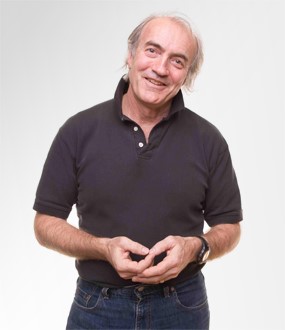By Rob Knies, Managing Editor, Microsoft Research
Bill Buxton (opens in new tab) is a man of many interests: composer, musician, outdoorsman. Most of all, though, he is a relentless advocate for innovative product design. “Ultimately,” he says, “we are deluding ourselves if we think that the products that we design are the ‘things’ that we sell, rather than the individual, social, and cultural experiences that they engender, and the value and impact that they have. Design that ignores this is not worthy of the name.” Buxton, a principal researcher for Microsoft Research, recently found a few minutes to discuss his work and his keynote for MIX09 (opens in new tab), the Web Design and Development Conference, held March 18-20 in Las Vegas.
Q: What do you plan to discuss during your MIX09 keynote?
Microsoft Research Podcast
Collaborators: Holoportation™ communication technology with Spencer Fowers and Kwame Darko
Spencer Fowers and Kwame Darko break down how the technology behind Holoportation and the telecommunication device being built around it brings patients and doctors together when being in the same room isn’t an easy option and discuss the potential impact of the work.
Buxton: Primarily two things. One is design at Microsoft and the “return on experience” that design can bring. We have a challenge to help accelerate the realization that Microsoft is not just starting to get design, but also is developing tools that help our customers and partners reap the benefits that improved experience design can bring. Toward this end, when I joined Microsoft about three years ago, there was only one senior person who had a design background. Now, there’s getting close to a dozen, and for the past two years, our user-experience head count has been growing at almost twice the rate as technologists! When we talk about “return on experience” to our partners, I want to make sure that it is clear that we are also walking the walk.

Bill Buxton
Things like the Arc™ Mouse (opens in new tab), the P-I Reader, the second-generation Zune, along with the Xbox, are all just wonderful examples of design. And I think that they reflect an important growth and transition in our company.
Over half of the people attending MIX are designers. They have confidence in us technologically. For interaction designers and people doing creative content, it’s good for them to understand how we think about design and what priority it takes with us.
The second thing I want to talk about, in terms of design practice, is the transformation in how we have to think about approaching design when we are dealing with rich media and interaction. How do we move to the new without throwing out the best of the past?
We lost some things along the way when we adopted digital media, simply because of the complexities of the technologies involved. With better tools, there’s a chance to recover a whole lot of the best practices of the design studio, practices that let us have far more freedom to explore different ideas early in the process so we have a much better chance to not only get the design right, but to get the right design.
One other thing I want to talk about, given that we’re all in a challenging economic situation, is how technology can help solve the problem and help us all be more successful. There’s a really strong precedent we can draw on: the history of industrial design.
Interaction and experience design today is exactly where industrial design was in 1929. From 1927 through ’29 is when the very first industrial-design practices started in the United States. Nobody ever had “industrial designer” on their business card before. People like Henry Dreyfuss, Raymond Loewy, and Walter Darwin Teague all started their practices right just before the Depression happened.
Think about it: what an idiotic time to start a private practice in a profession nobody has ever heard of before. And here’s the kicker: All three of those companies are still in business. They not only survived the Depression; they thrived in it. In fact, the companies that came out of the Depression healthy, insofar as anybody was healthy, were companies that employed the insights of design, principally from those three designers. That includes Bell, that includes the key players in the whiteware industry—refrigerators and stoves—and other consumer items, like Coca-Cola. It’s really, really fascinating.
The companies that employed those great designers absolutely reaped the “return on experience” that their services brought. My argument is that our partners can do the same for their clients in the economic climate of today.
Nobody can say that design has no value or it’s an expensive frill. Just the opposite. If those companies from the late 1920s had not brought real value to their clients, they would not exist. They wouldn’t have existed by 1935, much less in 2009.
Watch Bill Buxton’s MIX09 keynote address > (opens in new tab)
Q: What role does design play in the innovation cycle?
Buxton: Innovation, design, and risk all seem to me to be close cousins. For me, it is inconceivable to think about reproducible innovation, consistency in innovation, without an equal and interdependent cooperation of three pillars of an organization: creative design, business, and technology.
Whether you’re a small company or a company the size of Microsoft, you need equal strength at the top level in design, in technology, and in business. Each is essential, but none of them is sufficient. The innovation of one rarely stands alone from innovation of another. If you have a great new technological innovation and you bring it to the design and the business, they can innovate the business model, and they can innovate on the design based on that technology. Likewise, if you have a new business model, we can say, “Let’s juggle the design to take advantage of that.” You need that type of flexibility, where they’re working together as three equal partners at the head table from day one.
That’s a really important difference compared with how design has traditionally been treated, especially in the digital-technology sector, where design is generally a junior position that came in well after the fact and basically put a pretty dressing on technology that had been all but finished and specified and a business plan that had been completed before the designer came onboard.
Q: How have you seen the importance of design evolve over the years? Has it gained its rightful place in the product cycle?
Buxton: When we were living in the “Wild West” of the early digital revolution, we could get away with things that we can’t anymore. We’ve come through a certain transition. Standards have been established that have set expectations from our customers and users for a certain quality of experience when they purchase products, whether they be digital products, clothing, automobiles or even food. The days when we think that technology alone is going to give anyone a sustainable, competitive advantage are over, if they ever existed at all. We’ve seen several products which might not be the best in terms of the technologies, but they are the best in experience.
You could compare it to the food industry. We don’t buy food just for nutrition, but if you have good nutrition at a good price with spectacular presentation and experience, you’ll have a winner. If you serve exactly the same tasting food with a horrible experience because you haven’t thought about presentation, you haven’t thought about anything other than price and delivery, you’ll have a business, but it won’t be great.
Q: You used to be a musician. How did you get involved in this sort of work?
Buxton: It was an unplanned metamorphosis. I always believed I would be a performing musician. I happened to play synthesizers, electronic instruments. I got frustrated with the instruments I had at my disposal, and at a certain point, it became easier to learn how to design and build my own instruments than it was to deal with what I had available to me, in terms of what I wanted to do with it.
I started off designing musical instruments for myself and my friends, and I discovered something through rubbing shoulders with people at Xerox PARC who had seen my work: There are three levels of specification in technology. There’s normal specification, there’s military spec, and then there’s rock-and-roll spec. Though rock-and-roll spec is the hardest, that’s where I’d cut my teeth, so everything else seemed easy.
Of course, that’s an exaggeration, but the fact was that working with musical instruments started me off at the very beginning with things that worked in real time, had to be really responsive, had to be multithreaded, had to deal with multiple fingers at the same time—which led to some of the early multitouch work. Nearly all of my career has been around input devices, touch-sensitive devices, and new types of physical interaction. It all stemmed from what I learned from music. I think it’s because musicians have a longer history of expressing complex ideas through a technological medium than just about any other profession.
Q: If you were thinking about planning a user experience, what are the factors that would immediately jump to mind?
Buxton: The first thing I think about is what the customer base or the user is trying to accomplish. What’s the nature of the experience? They certainly aren’t buying a tool. They’re trying to accomplish something. What would they consider success?
Nobody wins an award for building a bridge that doesn’t fall down. The first thing I assume is you can get the technology right. I take that for granted, because I’m dealing with professionals.
Given that we can get the technology right, given that we can get the work done, what’s the point? What’s going to make the person smile? How do I measure or even characterize the notion of how I want them to feel or how they want to feel at the end of the day? And how can I design the system so I not only get that but I exceed that?
The problem with a lot of technology—and this goes back to why design is necessary—is that we’ve been delighting users to the extent we do just because they can get the right answer and get the work done, not because there is any great glow resulting from the way in which they are able to do so.
I would love to have our process at a point where people just take it for granted that technology does what it’s supposed to do and are delighted by the way in which it gets done. Then, what’s the nature of the delight? How do you achieve it? And how do you build that into the specification, where nothing less than that is deemed acceptable?
I will be happy when the first product is deemed to have a stop-ship bug—even though it has all of the features included and every line of code is proven correct—yet the product is stopped because the experience of using it is simply unacceptable. Then I think we’re starting to get to a mature world.
Q: You talked earlier about risk and the role it plays. How are you able to gauge the amount of risk appropriate to a particular project?
Buxton: My answer is couched in my experience in ice climbing.
How well does one prepare to manage risk in any business endeavor? The first thing is that one has to take on risk, because the most dangerous thing is to do nothing, to take no risk. Then you will just atrophy and disappear. It’s just inevitable. You have to take risk.
The question then is: Are you taking dangerous action, or are you mitigating risk? There’s a difference between risk and danger, and the difference is based on how you manage four things. This is true in ice climbing, it’s true in business, and it’s true in design:
- Do you have the right skills? Have you really educated yourself for what you’re about to do?
- Even if you have the skills, have you done your training? Are you fit? It doesn’t matter if you know how to ice-climb—if you’re not physically fit, you’re still dangerous when you’re on the rope.
- Do you have the right tools? That has a huge impact.
- Do you have the right partners? When I say partners, that might mean who’s on your team, or it might mean what other companies are involved.
Do you even know what the right skills, fitness, tools, and partners are for what you’re doing, and have you even thought about things in that kind of analysis? If you make a serious attempt to understand the right components for each of those four things, I think you can undertake something where there still is risk but the risk is absolutely acceptable relative to the potential benefits.
If I try to go up a vertical waterfall, it’s probably safer for me than it is for you to ride a bicycle in downtown Seattle. That’s analogous to our competitors if they go into some business venture where they haven’t done those four things. It’s like them trying to climb the waterfall without any experience or without having taken proper precautions. Any business decision we take, it’s the kind of analysis that one simply has to do.
Q: How do you envision the future of interactive design?
Buxton: The biggest change I see over the next 10 to 15 years is going to be a transition from where we cease to evaluate design and the experience of a company simply on the basis of some single product; rather, people are going to evaluate “experience” based on how products work together with the other technologies in the ecosystem. In this world of ubiquitous computing, where there are different types of information appliances—your car, your watch, your phone—how do these things work together as a society of appliances that exists within a society of people.
The biggest nut to crack is how that larger sense of interaction works in a way that is ethical, that is economically sustainable in terms of the larger ecosystem, and that reflects our collective values as a society.
It’s perhaps one of the most exciting periods in history to be in our industry and to be a designer in our industry. But even just as a citizen, at these times, it’s just great.
And if there was any place I’d want to be right now, it would be Microsoft. I can think of no company or organization that’s better positioned with the right skill sets to execute and bring about the future I absolutely believe is possible to bring about.





